List of Contents
Pharmaceutical Temperature Controlled Packaging Solutions Market Size and Forecast 2025 to 2034
The global pharmaceutical temperature controlled packaging solutions market size was calculated at USD 5.93 billion in 2024 and is predicted to increase from USD 6.36 billion in 2025 to approximately USD 11.50 billion by 2034, expanding at a CAGR of 6.80% from 2025 to 2034.
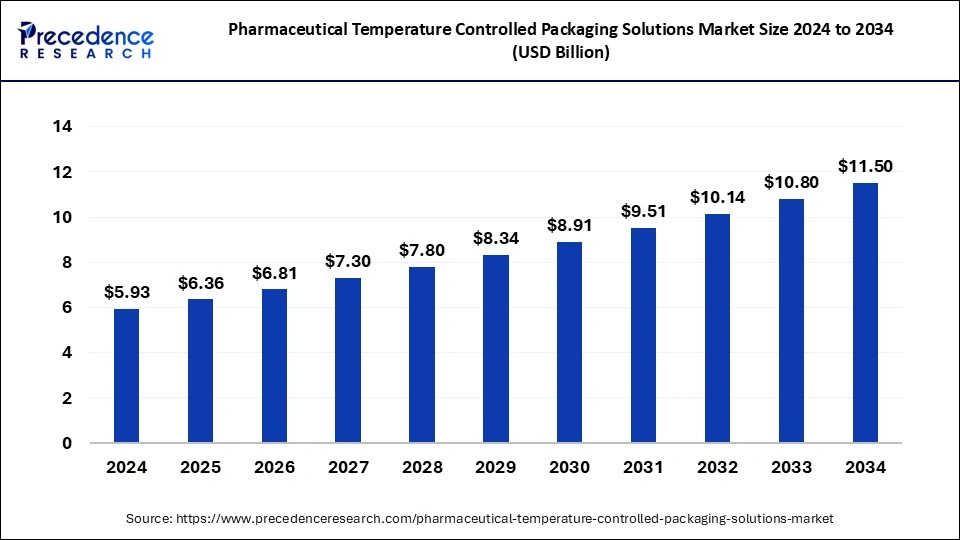
Pharmaceutical Temperature Controlled Packaging Solutions MarketKey Takeaways
- The global pharmaceutical temperature controlled packaging solutions market was valued at USD 5.93 billion in 2024.
- It is projected to reach USD 11.50 billion by 2034.
- The market is expected to grow at a CAGR of 6.80% from 2025 to 2034.
- North America led the global market with the highest market share of 32.02% in 2024.
- Asia Pacific region is estimated to expand the fastest CAGR of 8.08% between 2025 and 2034.
- By Application, the temperature-sensitive pharmaceutical segment has held the largest market share of 60.09% in 2024.
- By Product, the reusable segment captured the biggest revenue share of 65.34% in 2024.
- By product, the single-use solutions segment is anticipated to show considerable growth in the market over the forecast period.
AI Integration in the Pharmaceutical Temperature Controlled Packaging Solutions Market
The introduction of AI in the pharmaceutical market of temperature-controlled packaging solutions is transforming the industry through optimized monitoring, predictive data analytics, and automation. AI-based systems in the field of logistics enable developers to create optimal cold chains that predict temperature excursions with algorithmic precision and that simplify the route, as well as the control of goods in the stock.
Powerful algorithms allow real-time decision making to maintain the integrity of the products during storage and transit. AI presents an accurate control and visibility that is extremely vital in enhancing safe and reliable temperature-controlled packaging solutions.
U.S. Pharmaceutical Temperature Controlled Packaging Solutions Market Size and Growth 2025 to 2034
The U.S. pharmaceutical temperature controlled packaging solutions market size was exhibited at USD 1.53 billion in 2024 and is projected to be worth around USD 2.68 billion by 2034, growing at a CAGR of 5.73% from 2025 to 2034.
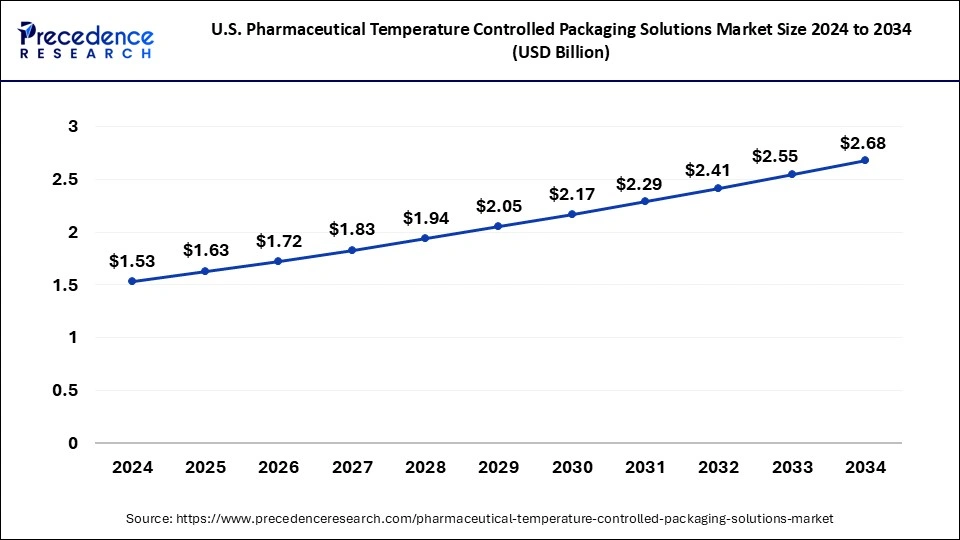
North America emerged as largest market for temperature-controlled packaging solutions for pharmaceuticals with considerable market share. The market is perceiving high growth on the background of escalating demand from healthcare industry. In this region, high demand for transportation vaccines, drugs and clinical trials has prompted the substantial growth of temperature-controlled packaging solutions. North America, particularly the U.S. is home to many recognized market participants those are involved in evolving technologies and process essential to develop cold chain system proficiently.The present strain of coronavirus has overturned the pharmaceutical supply chain across the globe which has become a foremost roadblock for significant market players. China's leading role as the ‘world's factory' and the domino effect of worldwide lockdowns, product slowdowns, dearth of raw materials, and labor scarcities are putting the international supply chain in general and North America's temperature-controlled pharma packaging marketplace in specific at risk.
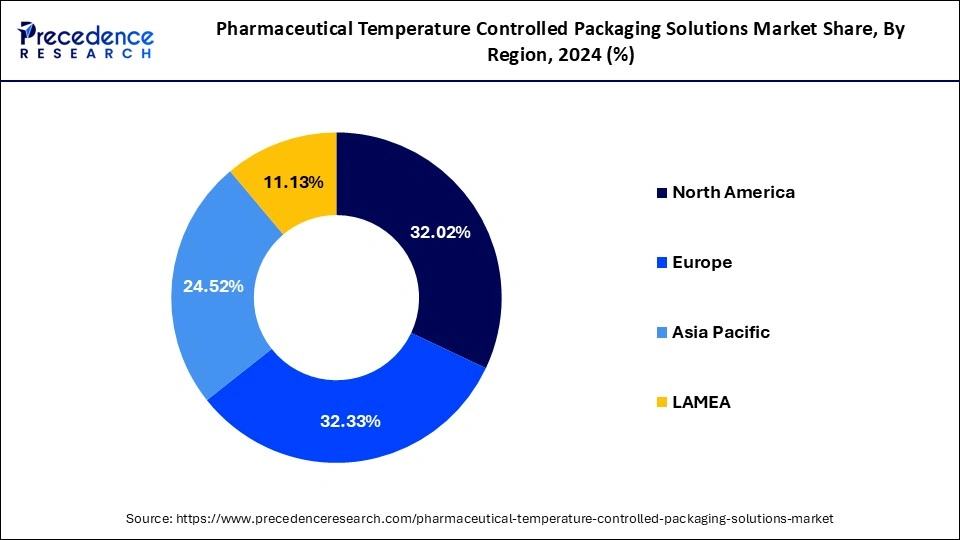
Pharmaceutical temperature-controlled packaging solutions industry in Asia Pacific is projected to grow at the highest CAGR during years to come. This growth can be attributed to the cumulative demand for insulated packaging from nations, such as Japan, China, and India.Asia Pacific is anticipated to perceive momentous growth on account of current stress of coronavirus as well as due to current restrictions on the export of numerous active pharmaceutical ingredients (APIs) from India. Further,restriction on high number of U.S. based generic drug manufacturers whose supply chain is profoundly dependent on Chinese suppliers is also stimulating market growth.
U.S. Pharmaceutical Temperature Controlled Packaging Solutions Market Trends
The pharmaceutical temperature-controlled packaging solutions in the U.S. are a market that is showing a persistently growing demand. The clinical trials would utilize strict temperature-controlled packs to ascertain the quality and efficiency of products during transportation and storage. Also, the recent growth in personalized medicine and cell and gene therapies has put an added strain on small-batch, high-value drugs.
The favorable regulatory framework, as well as developed logistics infrastructure, contribute to the application of new-age packaging technology into the U.S. market, including phase-change materials, vacuum-insulated panels, and tracking systems with the Internet of Things. Moreover, the increasing focus on sustainability is urging packaging firms to work on economically friendly single-use and reusable solutions.
China Pharmaceutical Temperature Controlled Packaging Solutions Market Trends
China's pharmaceutical temperature-controlled packaging solutions market is experiencing high expansion, and this is mainly attributed to the increased research and development interests in the drug industry. Such packaging options are also crucial in maintaining the integrity, stability, and efficacy of temperature-sensitive products in transportation, particularly over long distances or in different climatic regions.
The aging population in China, along with the growth in the number of chronic and infectious diseases, has contributed to a rise in the consumption of biologics and other drugs moving up the necessity new and advanced packaging systems. Also, pharmaceutical firms are increasing output to the international market, which has encouraged investment in premium compliance and high-functional packaging technology.
Europe Pharmaceutical Temperature Controlled Packaging Solutions Market Trends
The European pharmaceutical temperature-controlled packaging solutions market is expected to account for a substantial market share in 2024 due to the high regulatory requirements and the good logistic infrastructure. The European Medicines Agency (EMA) regulations of Good Distribution Practices (GDP) require that pharmacists apply validated high-performance packaging technology that will be able to ensure strict temperature conditions during storage and transportation.
These provide guidelines for the safe and efficient transportation of pharmaceuticals that have sensitive temperatures, including vaccines, biologics, and specialty drugs. Moreover, the interest of the region in minimizing carbon footprint and embracing sustainable processes has inspired an increase in sustainable solutions based on packaging.
The key markets in Europe that are focused on temperature-controlled packaging solutions to the pharmaceutical industry because it boasts of manufacturing strength and dominance in the biotechnology and specialty drugs segments. The trend of Germany towards innovation in personalized medicine and biotech has likewise increased the demand for high-tech systems in temperature-controlled packaging. Germany also has a good infrastructure, with logistics networks being compliant with GDP, special warehouses, and last-mile delivery services that support pharmaceutical demand.
AI Integration in the Pharmaceutical Temperature Controlled Packaging Solutions Market
The introduction of artificial intelligence in the pharmaceutical market of temperature-controlled packaging solutions is transforming the industry through optimized monitoring, predictive data analytics, and automation. AI-based systems in the field of logistics enable developers to create optimal cold chains that predict temperature excursions with algorithmic precision and that simplify the route, as well as the control of goods in the stock.
Powerful algorithms allow real-time decision making to maintain the integrity of the products during storage and transit. AI presents an accurate control and visibility that is extremely vital in enhancing safe and reliable temperature-controlled packaging solutions.
Market Overview
The pharmaceutical temperature-controlled packaging solutions market refers to the industry segment focused on providing packaging solutions specifically designed to maintain the temperature integrity of pharmaceutical products during transportation and storage. These solutions are crucial for preserving the efficacy and safety of temperature-sensitive medications and vaccines, which can be compromised if exposed to temperature fluctuations outside of their specified range. The market for pharmaceutical temperature-controlled packaging solutions encompasses a wide range of products and services, including insulated shipping containers, refrigerated packaging systems, temperature monitoring devices, data loggers, thermal blankets, and packaging materials with insulating properties.
Pharmaceutical Temperature Controlled Packaging Solutions Market Growth Factors
One of the most challenging supply chains include shipping temperature-controlled products from source to destination while preserving product temperature. Normal supply chains have numerous variables to manage to safeguard a successful outcome. Yet, when temperature control is encompassed another 30 to 40 variables add to the complication. Employment of firm government regulation and rulesby the government to progress the distribution practices of pharmaceutical goods are predictable to spur the market growth. As per the Food & Drug Administration (U.S.), Regulation 21 CFR 211.150 Distribution procedures, pharmaceutical products must be shipped insuitable temperatures and underneath accurate circumstances in harmony with necessities and suitable manual, electronic or electromechanical temperature and humidity recording equipment, and/or logs, devices must be used to document appropriate storage of prescription drugs.
Escalating research and development programs across the world for improving packaging and manufacturing process in pharmaceuticals and biotech sectors are predictable to bolster the market growth of temperature-controlled packaging solutions for pharmaceuticals. Furthermore, the swelling development of novel drugs and therapies like r-proteins, monoclonal antibodies stem cells together with pharmaceutical materials have elevated the demand for cold chain packaging system at numerous phases of product development, thus boosting the growth of the market. However, future demand for temperature-controlled packaging solutions is anticipated to be curtailed owed to rising concerns connected to the environmental influence of packaging waste and severe government rules for the same.
Market Scope
| Report Highlights | Details |
| Growth Rate from 2025 to 2034 | CAGR of 6.80% |
| Market Size by 2024 | USD 5.93 Billion |
| Market Size in 2025 | USD 6.36 Billion |
| Market Size by 2034 | USD 11.50 Billion |
| Largest Market | North America |
| Fastest Growing Market | Asia Pacific |
| Base Year | 2024 |
| Forecast Period | 2025 to 2034 |
| Segments Covered | Product Type, Application Type, Region |
Market Dynamics
Drivers
Increasing demand for biopharmaceuticals
The pharmaceutical temperature-controlled packaging solutions market is being driven by the global demand for biopharmaceuticals. Biopharmaceuticals, such as vaccines, proteins, and monoclonal antibodies, are often highly sensitive to temperature fluctuations. Maintaining their stability throughout the supply chain is critical to ensuring their efficacy and safety. Temperature-controlled packaging solutions are necessary to preserve the integrity of these delicate biologics.
The pharmaceutical industry has become increasingly globalized, with products often manufactured in one region and distributed to multiple countries worldwide. This complex supply chain necessitates robust temperature-controlled packaging solutions to ensure that biopharmaceuticals remain within their specified temperature range during transit across various climates and geographical locations.
Restraint
Environmental concerns
Many temperature-controlled packaging solutions rely on refrigerants and other materials that can have a negative impact on the environment. As environmental regulations become stricter, pharmaceutical companies may face pressure to adopt more sustainable packaging solutions, which could restrain the market growth of traditional temperature-controlled packaging. Temperature-controlled packaging solutions must be compatible with various transportation modes, including air, sea, and land. Ensuring compatibility across different transportation networks can be challenging and may limit the adoption of certain packaging solutions.
Opportunity
Technological advancements
With advancements in sensor technology and IoT (Internet of Things), temperature-controlled packaging solutions can now offer more precise monitoring and control of temperature-sensitive pharmaceuticals during storage and transportation. This ensures the efficacy and safety of the drugs, reducing the risk of spoilage or degradation. Technologies such as blockchain can be integrated into
temperature-controlled packaging solutions to enhance security and traceability. This ensures that pharmaceutical products are not tampered with or counterfeited during transit, maintaining their integrity and safety.
Application Insights
In 2024, the temperature-sensitive pharmaceutical segment held the largest share of the market. Pharmaceutical products, especially certain medications, vaccines, and biologics, are highly sensitive to temperature variations. Even slight deviations from the recommended storage conditions can lead to degradation or loss of efficacy. Therefore, there's a critical need for temperature-controlled packaging solutions to maintain the integrity of these products during storage and transportation.
The demand for temperature-sensitive pharmaceuticals is consistently high due to the increasing prevalence of chronic diseases, the growing aging population, and the development of biologic drugs and vaccines. As a result, pharmaceutical companies need reliable temperature-controlled packaging solutions to deliver their products safely to patients, healthcare providers, and distribution centers worldwide.
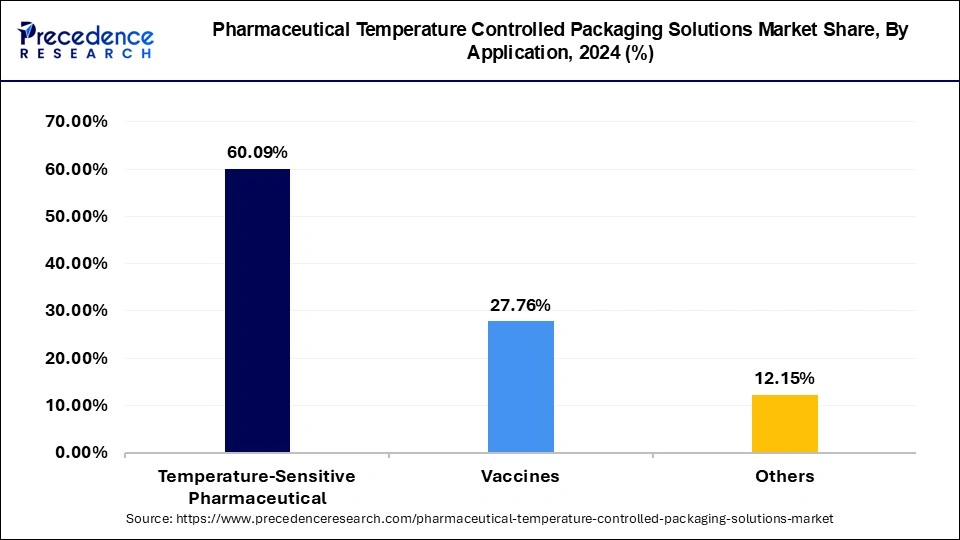
The vaccines segment is observed to grow at the fastest rate during the forecast period. Vaccines are often highly sensitive to temperature variations. They require precise temperature control to maintain their efficacy. This necessity for precise temperature control drives the demand for sophisticated temperature-controlled packaging solutions. With the development of new vaccines and the expansion of existing immunization programs, there's a growing need for vaccine production and distribution on a larger scale. This increased volume of vaccines being transported necessitates efficient and reliable temperature-controlled packaging solutions to safeguard their integrity throughout the supply chain.
Global Pharmaceutical Temperature Controlled Packaging Solutions Market Revenue, By Application, 2022-2024 (USD Million)
| By Application | 2022 | 2023 | 2024 |
| Temperature-Sensitive Pharmaceutical | 3,110.13 | 3,330.71 | 3,563.91 |
| Vaccines | 1,399.90 | 1,518.73 | 1,646.25 |
| Others | 634.71 | 676.76 | 720.74 |
Product Insights
The single-use solutions segment is expected to grow at a significant CAGR over the forecast period, which can be attributed to the surging demand for stable and affordable temperature-controlled packaging in the pharmaceutical industry. Phase-change materials (PCMs), PPC materials, meat-insulated shipping containers, and refrigerated pallets are applied to control temperature situations at various points of the supply chain with a target of maintaining specific temperature intervals.
They are logistical and will minimize the chance of cross-contamination, which is very important in the transportation of drugs. The increased production of single-use products is also due to the increased demand to put product security, regulation, and interruption of the cold chain.
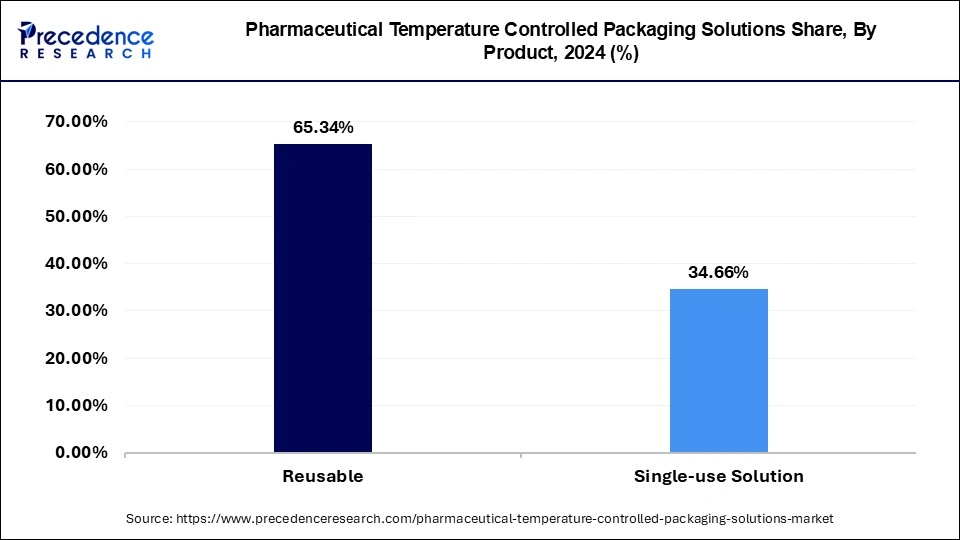
Global Pharmaceutical Temperature Controlled Packaging Solutions Market Revenue, By Product, 2022-2024 (USD Million)
| By Product | 2022 | 2023 | 2024 |
| Reusable Solutions | 3,375.20 | 3,618.20 | 3,875.41 |
| Single Use Solutions | 1,769.54 | 1,908.00 | 2,055.49 |
Recent Developments
- In January 2025, DS Smith, a packaging company, announced the launch of the temperature-supports packaging solution that serves the pharma industry. Through the innovative temperature-controlled packaging solution, DS Smith offers its services to the pharmaceutical industry. The solution will assist pharmaceutical and biotech organizations in achieving their sustainability objectives by taking care of their demand to transport and maintain sensitive drugs within controlled air temperatures in more than one country.
- In January 2024, Envirotainer, the company, is ranked at the top in safe cold chain solutions to pharmaceutical air transportation, and the firm won the Best Temperature Control Packaging Provider - Active at the 2024 Biopharma Excellence Awards consecutively for a second time.
- In September 2023, the phase-change material (PCM) technology company Pluss Advanced Technologies (PLUSS) revealed it had launched two new temperature-controlled packaging solutions for the pharmaceutical industry: Celsure year XL Pallet Shipper series and Celsure year VIP Multi-Use Parcel Shipper series.
Key Companies & Market Share Insights
The rising emphasis of manufacturers to make use of reusable packaging containers is probable to support the growth of the pharmaceuticals temperature-controlled packaging solutions market. On account of regulatory pressure and the necessity to diminish transportation costs, merchants are concentrating on approving reusable packaging containers than one-way or disposable systems as it decreases the practice of insulation products and refrigerants that are linked with global warming and ozone depletion. The above-mentioned influences are expected to substitute the growth of the market across the world during estimated period.
The majority of the crucial players uphold a strategic focus on North American and Western European markets, on account of the high penetration of related products in the region, while APEJ is also striking a market with nations such as China and India with astonishing healthcare and medical facilities. Foremost market companies in the pharmaceuticals temperature-controlled packaging solutions market are also directed on the development of new-fangled products with improved properties, at the same time cost competitiveness will endure a robust differentiation strategy.
Pharmaceutical Temperature Controlled Packaging Solutions Market Companies
- Pelican Biothermal
- Cryopak
- Sonoco Products Company
- Envirotainer
- DS Smith Pharma
- Cold Chain Technologies
- World Courier
- Intelsius
- CSafe
- Softbox Systems
- Skycell
- Va-Q-tec AG
- Sofrigam
Recent Developments
- In January 2025, DS Smith, a packaging company, announced the launch of the temperature-supports packaging solution that serves the pharma industry. Through the innovative temperature-controlled packaging solution, DS Smith offers its services to the pharmaceutical industry. The solution will assist pharmaceutical and biotech organizations in achieving their sustainability objectives by taking care of their demand to transport and maintain sensitive drugs within controlled air temperatures in more than one country.
- In January 2024, Envirotainer, the company, is ranked at the top in safe cold chain solutions to pharmaceutical air transportation, and the firm won the Best Temperature Control Packaging Provider - Active at the 2024 Biopharma Excellence Awards consecutively for a second time.
- In September 2023, the phase-change material (PCM) technology company Pluss Advanced Technologies (PLUSS) revealed it had launched two new temperature-controlled packaging solutions for the pharmaceutical industry: Celsure year XL Pallet Shipper series and Celsure year VIP Multi-Use Parcel Shipper series.
Segments Covered in the Report
By Product
- Reusable Solutions
- Single Use Solutions
By Application
- Temperature-Sensitive Pharmaceuticals
- Vaccines
- Others
By Region
- North America
- U.S.
- Canada
- Europe
- U.K.
- Germany
- France
- Asia Pacific
- China
- India
- Japan
- South Korea
- Middle East & Africa
- Latin America
For inquiries regarding discounts, bulk purchases, or customization requests, please contact us at sales@precedenceresearch.com
Frequently Asked Questions
Ask For Sample
No cookie-cutter, only authentic analysis – take the 1st step to become a Precedence Research client